Luxury Coastal Home Decor Ideas: Elevate Your Beach House with Timeless Elegance

Contents
- Introduction
- 1. The Foundation: Neutral Palettes That Mirror the Coast
- 2. Materials That Age Gracefully: Beyond Plastic and Pine
- 3. Lighting: Mimicking the Coast’s Natural Rhythms
- 4. Furniture: Relaxed Silhouettes with Luxe Details
- 5. Art: Telling a Coastal Story Without Clichés
- 6. Textiles: Where Luxury and Practicality Collide
- 7. Hardware & Fixtures: The Small Details That Make a Big Impact
- 8. Outdoor Spaces: Extending the Coastal Vibe
- 9. Plants & Greenery: Bringing the Coast’s Organic Life Indoors
- 10. Personal Touches: Making It Yours
- Conclusion
Introduction
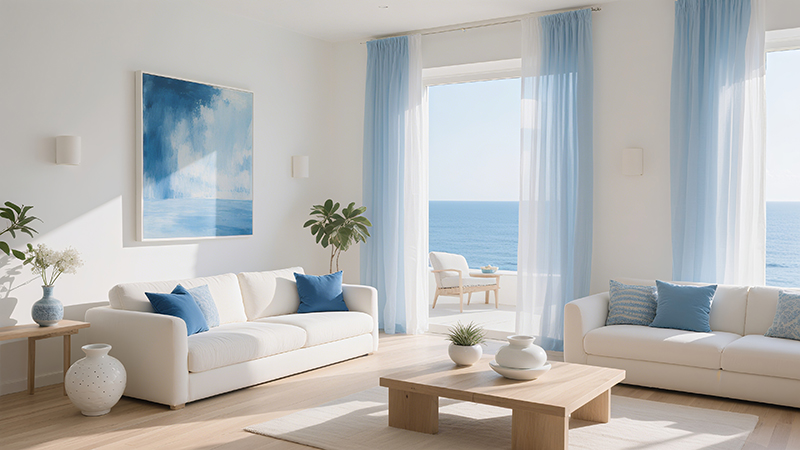
The allure of coastal living—soft sea breezes, golden light, and the quiet rhythm of waves—has long captivated homeowners. But for those seeking luxury, coastal decor often feels trapped in a cycle of kitsch: think oversize seashells, neon sailboat prints, and plastic “beachy” trinkets. The truth is, high-end coastal style isn’t about literal references to the ocean—it’s about capturing its essence: airiness, warmth, and a sense of effortless refinement.
In Western markets, where beachfront properties and coastal-inspired homes are coveted, the demand for elevated coastal design is booming. Homeowners want spaces that feel like a permanent vacation—relaxed enough for sandy feet, yet sophisticated enough for dinner parties. This guide breaks down the art of crafting a luxury coastal home that balances comfort and elegance, steering clear of clichés while honoring the spirit of the coast. From color palettes to hardware, we’ll explore how to infuse your space with coastal charm that feels personal, timeless, and uniquely yours.
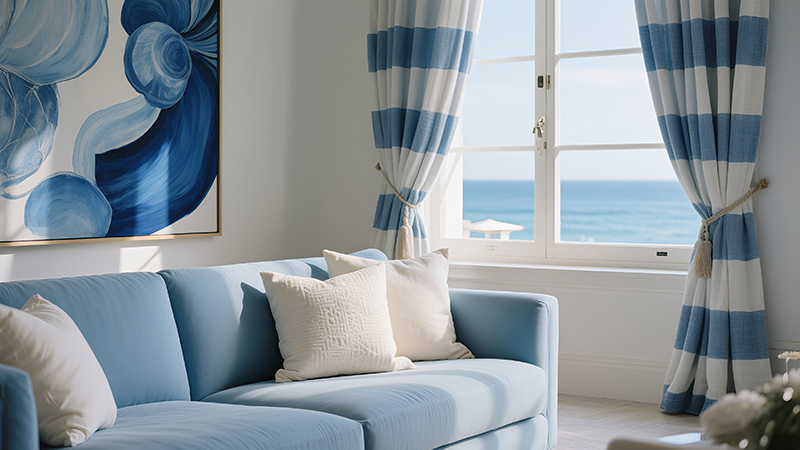
1. The Foundation: Neutral Palettes That Mirror the Coast
Coastal luxury starts with color—but not the bright blues and corals you might expect. The most elevated coastal spaces draw from the soft, muted hues of the shoreline: think weathered sand, foggy mornings over the water, and the pale gray of driftwood.
- Walls: Opt for warm whites (like Benjamin Moore’s “White Dove”) or soft grays (Sherwin-Williams’ “Repose Gray”) in matte or eggshell finishes. These tones reflect natural light, making rooms feel larger and airier—critical for coastal homes where sunlight is abundant. Avoid glossy paints, which create harsh glares that clash with the coast’s gentle glow.
- Accents: Layer in subtle hints of color inspired by local landscapes. In New England, soft sage greens (echoing dune grass) work beautifully; in Malibu, terracotta (mimicking sun-baked cliffs) adds warmth. These accents should be used sparingly—think a single accent wall or a throw pillow—to keep the focus on light and texture.
- Pro Tip: Use varying shades of your base color to add depth. A living room with off-white walls, a slightly warmer white sofa, and cool-gray linen curtains creates visual interest without feeling busy.
Why this works for Western markets: Neutral palettes align with the European and American preference for “timelessness.” They’re easy to update with seasonal decor and appeal to a broad range of tastes, making them ideal for both permanent homes and vacation properties.

2. Materials That Age Gracefully: Beyond Plastic and Pine
Luxury coastal decor hinges on materials that tell a story—ones that patina, weather, and soften over time, just like the coast itself. Forget flimsy wicker or mass-produced plastic; instead, invest in pieces that grow more beautiful with wear.
| Material | Why It Works for Coastal Spaces | Best Uses |
| Reclaimed Teak | Resists salt, moisture, and warping; develops a silvery gray patina. | Dining tables, outdoor furniture, accent chairs. |
| Honed Limestone | Mimics the texture of weathered cliffs; porous surface adds organic charm. | Countertops, floor tiles, fireplace surrounds. |
| Brass (Unlacquered) | Develops a rich, greenish-blue patina over time, evoking aged ship hardware. | Faucets, drawer pulls, light fixtures. |
| Bleached Oak | Light tone reflects sunlight; subtle grain resembles driftwood. | Flooring, bookshelves, bed frames. |
- Avoid These: Shiny synthetic materials (like acrylic or polished resin) feel cheap and clash with the coast’s organic vibe. Even “beachy” staples like rattan can read as kitsch if overused—opt for high-quality woven rattan (not plastic replicas) in small doses, such as a single accent chair.
Example: A Rhode Island kitchen featuring reclaimed teak cabinetry, honed limestone countertops, and unlacquered brass hardware. Over three years, the teak has faded to a soft silver, the limestone has absorbed subtle stains (adding character), and the brass has developed a gentle patina—all working together to create a space that feels “lived-in” yet luxurious.
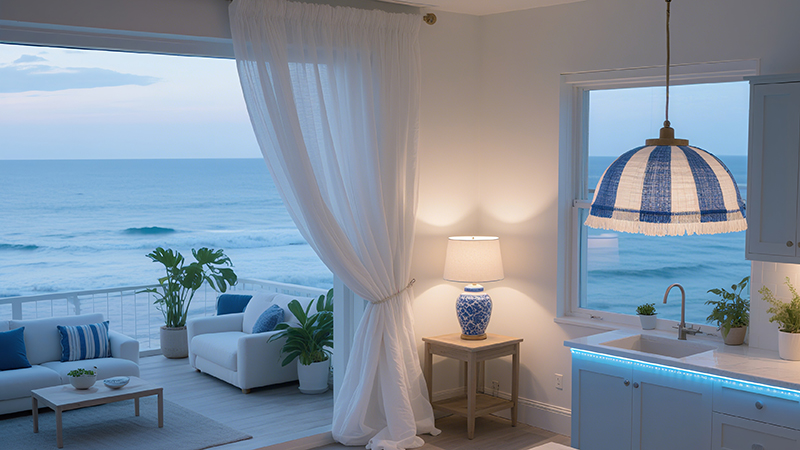
3. Lighting: Mimicking the Coast’s Natural Rhythms
Coastal light shifts dramatically from dawn to dusk—soft pastels at sunrise, bright and golden at midday, warm and amber as the sun sets. The best coastal lighting designs mimic this natural flow, creating ambiance that evolves with the day.
- Morning: Focus on soft, diffused light. Install dimmable wall sconces with linen shades (try Schoolhouse Electric’s “Hughes Sconce”) near windows to amplify natural light without harshness. In bedrooms, bedside table lamps with ceramic bases in muted blues or greens cast a gentle glow, perfect for early mornings with coffee.
- Afternoon: Let sunlight take center stage, but soften it with sheer linen curtains. Add LED strip lights under kitchen cabinets or bookshelves to counteract harsh midday shadows—they’ll kick in subtly, preventing spaces from feeling too bright or cold.
- Evening: Embrace warm, low light. Hang an oversized jute or linen pendant light (like CB2’s “Jute Drum Pendant”) over living room seating areas; its texture casts dappled shadows, mimicking sunlight filtering through boat rigging. For outdoor spaces, string globe lights (with warm LED bulbs) between trees to echo the twinkle of stars over water.
- Mistake to Avoid: Overhead “can” lights. They flood rooms with harsh, uniform light that erases the cozy, layered feel critical to luxury coastal design. Stick to sconces, table lamps, and pendants for a more organic look.
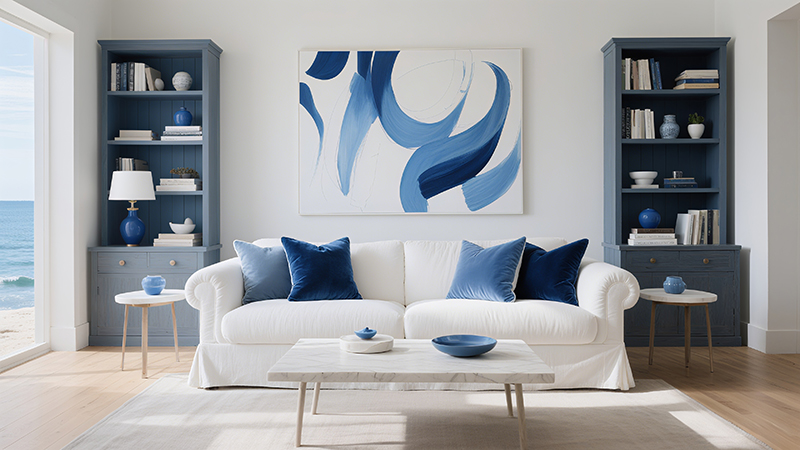
4. Furniture: Relaxed Silhouettes with Luxe Details
Coastal furniture should invite you to kick off your shoes, but that doesn’t mean sacrificing elegance. The key is “undone” luxury—pieces with casual shapes but high-end materials that feel both approachable and refined.
- Sofas & Sectionals: Opt for deep, sink-in styles with slipcovers in performance linen (try Crypton or Sunbrella fabrics for stain resistance). A sectional in soft white or light gray linen works as a blank canvas; add feather-filled cushions for plushness, but keep the frame streamlined to avoid a cluttered look. For a pop of color, layer in a custom velvet throw pillow (navy or sage) with a subtle texture, like ribbing or embroidery.
- Dining Furniture: Skip formal dining sets. Instead, choose a reclaimed teak table with a live edge (its irregular shape adds coastal character) paired with woven rush-seat chairs (for texture) and one statement chair in velvet (for contrast). In smaller spaces, an extendable vintage campaign table (with brass hardware) adds versatility—perfect for hosting guests or folding down for intimate meals.
- Accent Pieces: Oversized ottomans in indoor-outdoor fabric (spills wipe clean) double as extra seating or coffee tables. Vintage trunks (used as side tables) add storage and a nod to coastal history—think old sea chests—without literal nautical motifs.
Example: A Nantucket living room features a slipcovered linen sectional, a reclaimed oak coffee table, and a vintage brass-and-wood campaign desk (used as a media console). The pieces feel relaxed enough for kids with sandy feet but polished enough for adult gatherings—striking the perfect coastal balance.

5. Art: Telling a Coastal Story Without Clichés
Art is where you can infuse personality into your coastal home—if you skip the obvious. Leave the sailboat prints and lighthouse posters at the boardwalk; instead, choose pieces that evoke the coast’s mood, history, or landscape in subtle ways.
- Abstract Seascapes: Look for paintings in muted tones—soft blues, grays, and creams—that suggest waves or mist without depicting them directly. A large abstract piece over a sofa (like works by artist April Gornik) becomes a focal point without screaming “beach.”
- Black-and-White Photography: Capture local coastal moments—waves crashing against rocks, weathered docks at low tide, or salt marshes at dawn. Frame them in simple black or natural wood frames to keep the focus on the image. Bonus points for shots of landmarks meaningful to you, like a favorite beach or cliffside trail.
- Vintage Maps & Charts: Framed nautical charts of your local coastline (or a beloved vacation spot) add history and sophistication. For example, a map of Cape Cod in a weathered oak frame brings in coastal nostalgia without kitsch.
- Ceramic or Stone Sculptures: Wall hangings or tabletop pieces resembling eroded rocks, barnacles, or tide pools (try artists like Lisa Madigan) add texture and organic shape, echoing the coast’s natural formations.
- Placement Tip: Hang art at eye level (57–60 inches from the floor) and leave 2–3 inches of space between pieces for a curated look. In rooms with white walls, group 2–3 pieces (in varying sizes) to create a gallery wall that adds visual weight.
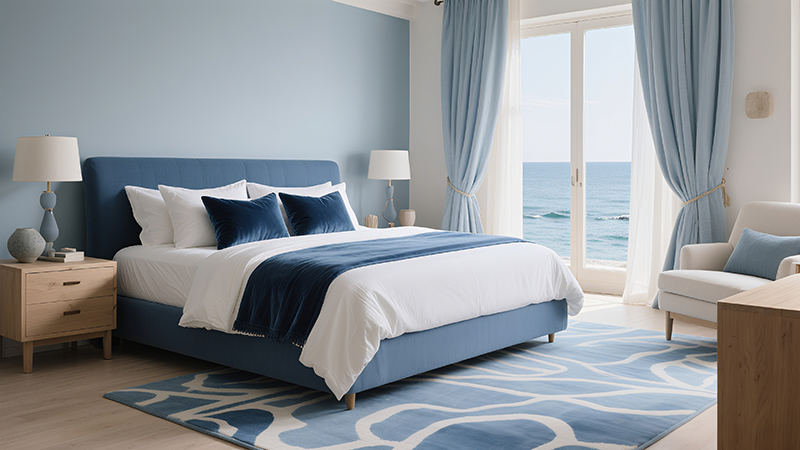
6. Textiles: Where Luxury and Practicality Collide
Coastal homes demand textiles that work as hard as they look good. Sandy feet, wet swimsuits, and accidental spills are part of life by the water—so fabrics need to be durable, but they shouldn’t feel like they belong in a garage.
- Curtains: Belgian linen is ideal—its loose weave softens sunlight without blocking it, and it gets softer with each wash. Look for unlined styles in off-white or light gray; they’ll billow gently in sea breezes, adding movement to the room.
- Rugs: Wool-blend rugs (80% wool, 20% synthetic) are a smart choice. Wool resists stains and hides dirt, while the synthetic blend adds durability. Opt for organic patterns—subtle stripes, abstract waves, or muted geometric shapes—in neutral tones to ground the space.
- Throws & Pillows: Velvet (yes, velvet!) is surprisingly practical—its tight weave repels spills, and most stains wipe off with a damp cloth. Look for washed silk or cotton velvet in deep blues, soft greens, or sandy beiges. Pair with chunky knit throws in wool or cotton; their texture adds coziness without looking messy.
Example: A Charleston bedroom features floor-to-ceiling Belgian linen curtains, a wool-blend rug with a subtle wave pattern, and a mix of velvet pillows (navy and sage) and a chunky cream knit throw. The textiles feel luxurious but stand up to kids, pets, and the occasional sandy footprint.
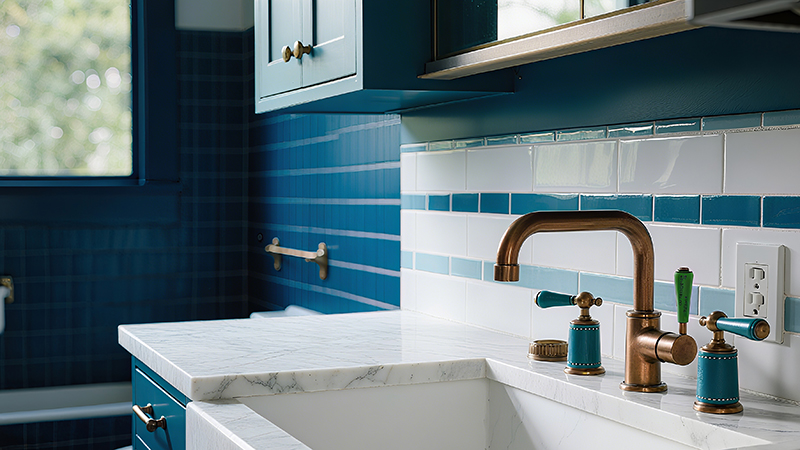
7. Hardware & Fixtures: The Small Details That Make a Big Impact
It’s easy to overlook hardware—doorknobs, faucet handles, switch plates—but in coastal design, these small elements are where “theme” vs. “elegance” is decided. Swap shiny, modern finishes for ones that feel organic and aged, echoing the coast’s weathered beauty.
- Kitchen & Bath Faucets: Brushed brass (not polished) has a warm, lived-in look, while unlacquered brass develops a unique patina over time—think the soft greenish tint of old ship fixtures. For a more rustic vibe, try matte black (like Waterworks’ “Soho Faucet”) paired with reclaimed wood cabinetry.
- Drawer & Cabinet Pulls: Leather pulls (in tan or dark brown) soften hard surfaces and develop a rich, worn texture with use. For a beachy touch without kitsch, opt for rope-wrapped pulls (but use them sparingly—one or two in a kitchen, not every cabinet).
- Light Switches & Outlet Covers: Clay, terracotta, or hand-glazed ceramic covers add subtle texture. They’re a small detail, but they replace cold plastic with warmth, tying into the organic feel of coastal spaces.
Example: A Santa Barbara bathroom features unlacquered brass shower fixtures, leather drawer pulls, and terracotta switch plates. Over time, the brass has developed a soft patina, the leather has darkened, and the terracotta has absorbed subtle moisture marks—all combining to create a space that feels like a curated, well-loved retreat.
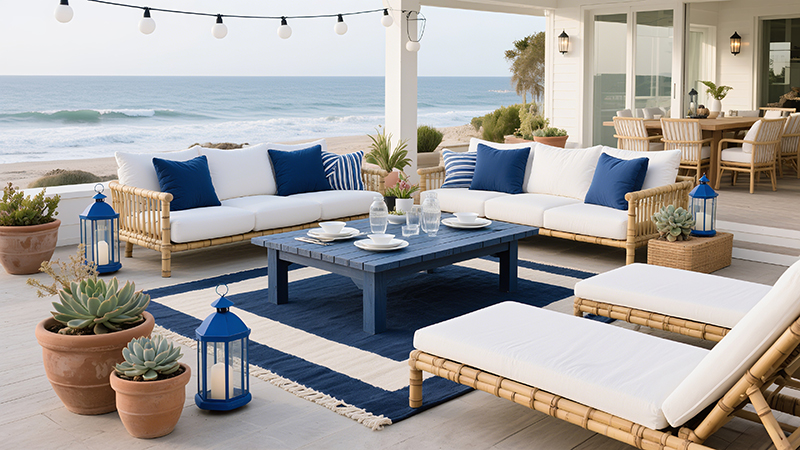
8. Outdoor Spaces: Extending the Coastal Vibe
In Western markets, outdoor living is a cornerstone of coastal life—think morning coffee on the porch, evening dinners under the stars, or lazy afternoons by the pool. Your outdoor space should feel like an extension of your interior, with the same focus on comfort and elegance.
- Furniture: Choose teak or aluminum (with a weathered finish) outdoor sofas and chairs, upholstered in Sunbrella fabric (water- and fade-resistant) in soft neutrals or muted blues. Add outdoor rugs (jute or polypropylene) to define the space and bring in texture.
- Shade Solutions: A woven rattan pergola or canvas awning (in natural beige) softens harsh sunlight. For smaller spaces, a large umbrella (in light gray or navy) with a wooden pole adds shade without blocking views of the water.
- Accents: Ceramic planters (in terracotta or white) filled with drought-resistant plants (succulents, lavender, or sea grass) bring in greenery. String lanterns or hurricane candles with driftwood bases add ambiance for evening gatherings.
- Pro Tip: Match your outdoor textiles to your indoor ones (e.g., the same shade of linen for outdoor cushions and indoor throw pillows) to create a seamless flow between spaces.
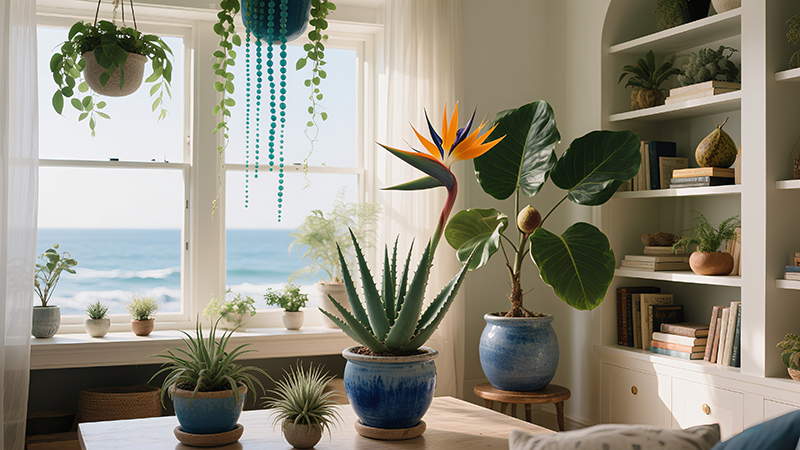
9. Plants & Greenery: Bringing the Coast’s Organic Life Indoors
Coastal interiors thrive with greenery that echoes the shore’s natural landscapes. Choose plants that look like they belong by the water—hardy, low-maintenance, and with textures that mirror dunes, marshes, or cliffs.
- Large Floor Plants: Fiddle-leaf figs (with their broad, waxy leaves) add height and drama, resembling coastal trees. Bird of paradise plants, with their tropical fronds, evoke beachside jungles without feeling over-the-top.
- Tabletop Plants: Succulents (like jade or aloe) and air plants (tillandsias) thrive in bright, humid coastal air. Display them in terracotta pots or driftwood planters for a natural look.
- Hanging Plants: Pothos or string of pearls (with trailing vines) add softness when hung near windows. Their cascading leaves mimic the movement of seaweed in water.
- Care Note: Most coastal plants prefer bright, indirect light (avoid direct afternoon sun) and occasional misting to mimic sea air humidity.
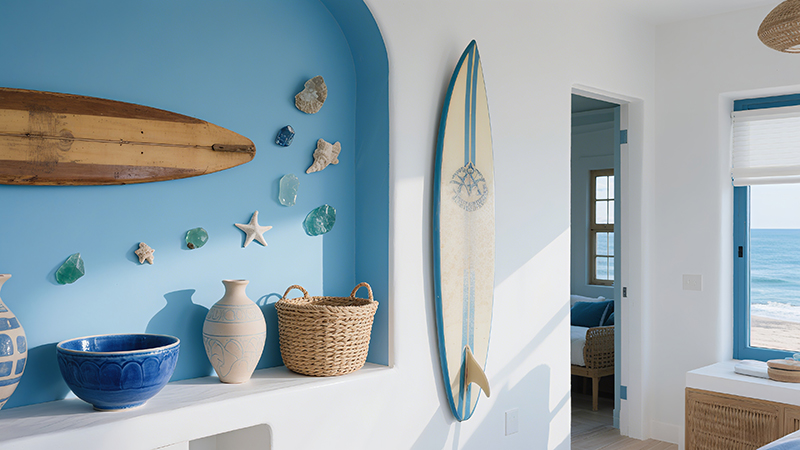
10. Personal Touches: Making It Yours
The most luxurious coastal homes feel personal—they tell the story of who lives there, not just a generic “beach house” aesthetic. Add touches that reflect your hobbies, travels, or family history to avoid a “staged” look.
- Family Heirlooms: A vintage surfboard (passed down from a grandparent) mounted on a wall becomes art with meaning. A collection of sea glass (collected on morning walks) displayed in a glass jar adds color and nostalgia.
- Travel Finds: A handwoven basket from a trip to Greece, a ceramic bowl from a market in Portugal, or a rug from Morocco—pieces from coastal regions around the world add global flair while tying into the coastal theme.
- Hobby-Inspired Decor: If you sail, display a vintage compass or nautical knot (tied by you) on a bookshelf. If you hike coastal trails, frame pressed wildflowers from your favorite paths.
Example: A Portland, Maine home features a wall of family photos (taken at local beaches over the years), a surfboard from the 1960s (used by the homeowner’s father), and a collection of hand-thrown pottery (made by the homeowner) inspired by tide pools. These touches turn a beautiful space into a lived-in home.
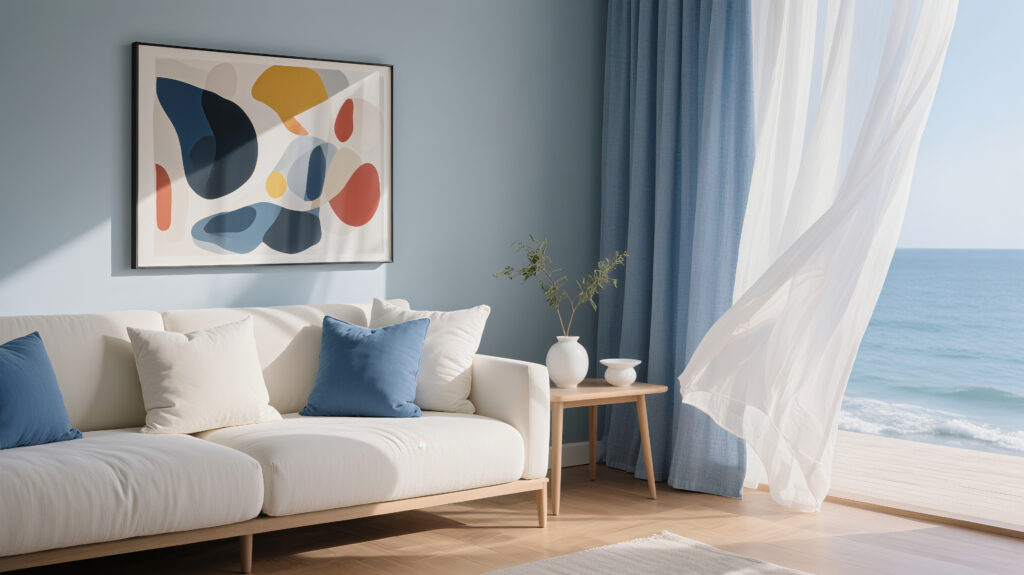
Conclusion
Luxury coastal home decor isn’t about seashells, sailboats, or bright blues—it’s about capturing the coast’s essence: light, texture, and a sense of relaxed elegance. By focusing on neutral palettes, aging materials, layered lighting, and personal touches, you can create a space that feels both luxurious and lived-in—a true reflection of coastal life at its best.
Remember: The goal is to design a home that works for you—whether you’re hosting a summer barbecue, curling up with a book on a rainy day, or watching the sunset over the water. With these ideas, you’ll craft a coastal retreat that’s timeless, sophisticated, and uniquely yours.


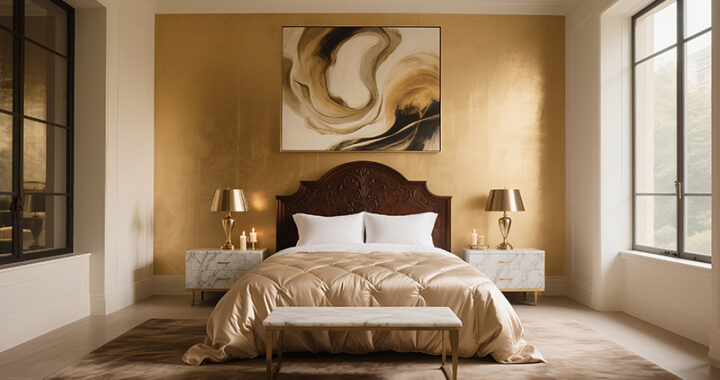 Home Decor Ideas to Make Your Home Feel Like a Luxury Hotel
Home Decor Ideas to Make Your Home Feel Like a Luxury Hotel 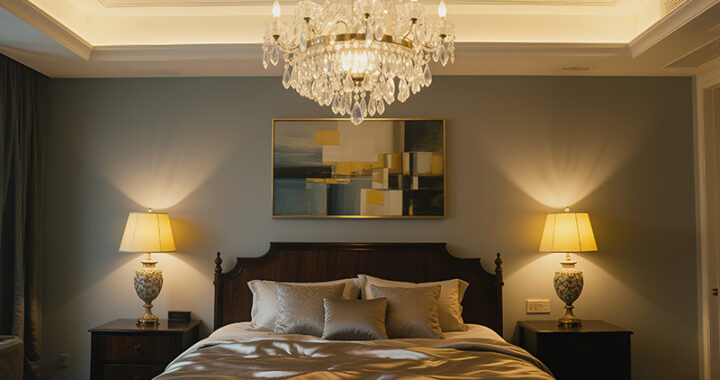 Best Luxury Accent Lighting for Every Room
Best Luxury Accent Lighting for Every Room 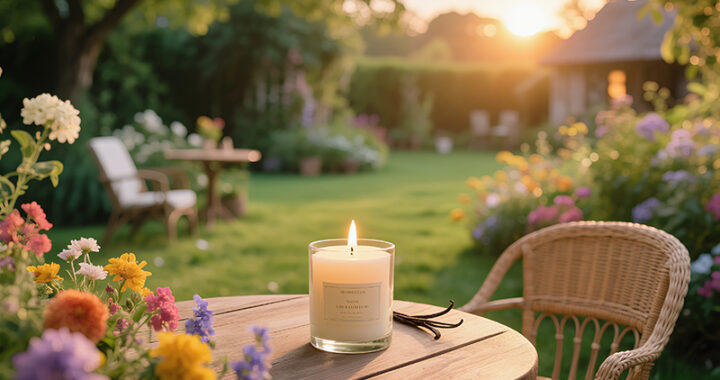 Best Luxury Candles for a Cozy and Elegant Home
Best Luxury Candles for a Cozy and Elegant Home 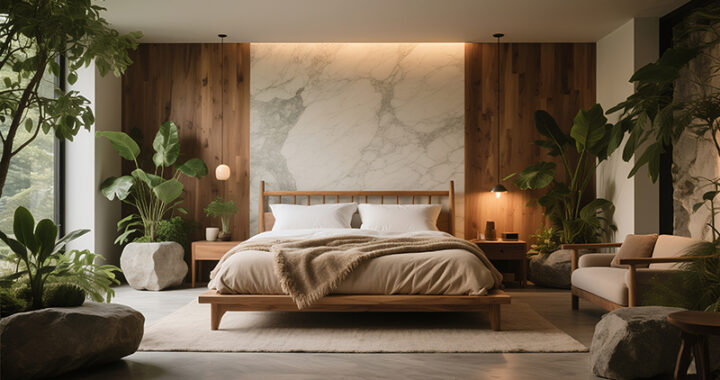 Best Luxury Bed Frames for a Stylish Bedroom
Best Luxury Bed Frames for a Stylish Bedroom 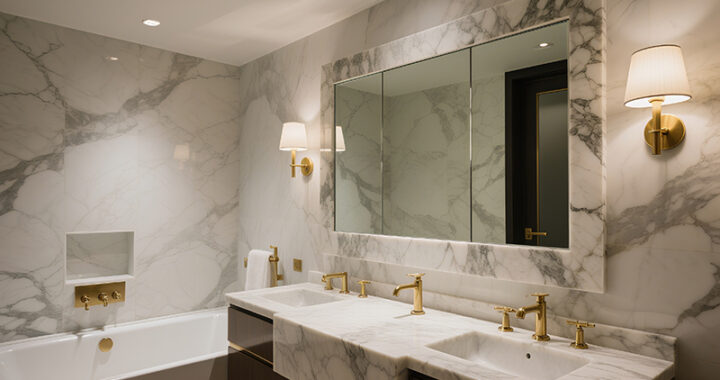 Best Luxury Bathroom Mirrors for a Stylish Touch
Best Luxury Bathroom Mirrors for a Stylish Touch 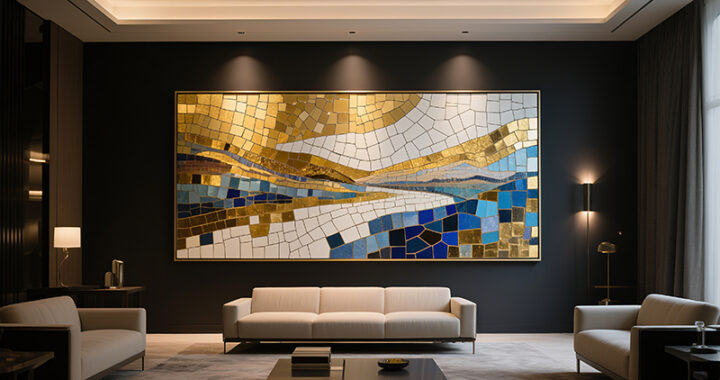 Luxury Statement Wall Art: Elevating Homes with Timeless Impact
Luxury Statement Wall Art: Elevating Homes with Timeless Impact 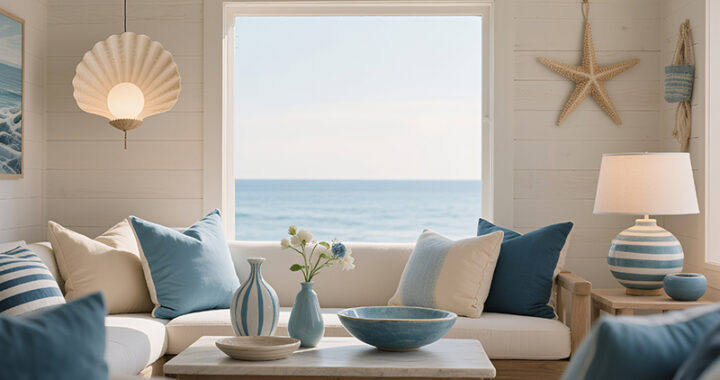 Luxury Coastal Home Decor Ideas: Elevate Your Beach House with Timeless Elegance
Luxury Coastal Home Decor Ideas: Elevate Your Beach House with Timeless Elegance